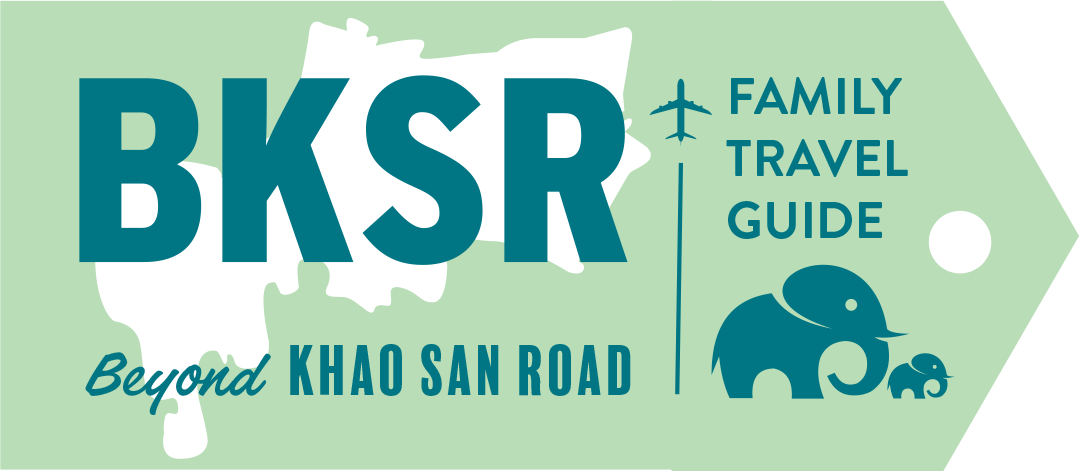Of all the cities we have visited in South America with our children, Buenos Aires is our favourite. Simmering with a vibrant mixture of culture, history and fun, all spiced with Latin passion, it offers much to adults and children alike. From fascinating museums and extravagant parks to bustling markets and delicious food there is so much to see and experience. As a family vacation destination, we can heartily recommend exploring Buenos Aires with Kids.
It has earned the nickname “Paris of the South” for a good reason: the grand architecture matches any European city and offers a sophisticated, cosmopolitan feel. Unlike the sprawling acres of concrete displayed by other cities in the region (looking at you, Rio!), it blends tradition and modernity with a diverse heritage. The warm, welcoming culture is ideal for families looking for a genuine experience and somewhere to make memories together. It is no surprise that Buenos Aires is the second most visited city in South America after Mexico City.

All prices are correct at the time of writing, but inflation in Argentina is currently running at 120%, so they will almost certainly be out of date by the time you read this!
While travelling with kids can be tough, Buenos Aires makes it easy. It has great, child-friendly places to stay, colourful neighbourhoods, and enough attractions to fill a week. Also, it is easy to get around and lacks the somewhat rough reputation of other cities (again, looking at you, Rio!)
Buenos Aires with kids is an adventure waiting to happen; get ready to discover this magnificent city together!
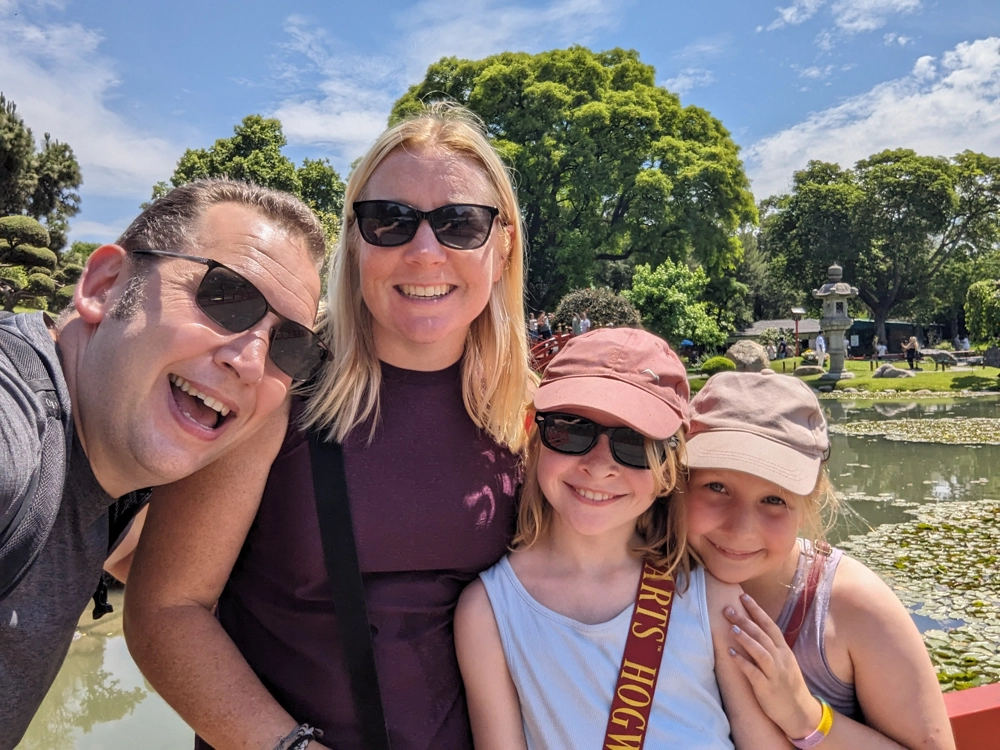
Our Map Of Things to Do in Buenos Aires with Kids
Getting To And From Buenos Aires
Flying into BA is like flying into any major city. Ezeiza International Airport is reasonably easy to navigate, even with jet-lagged kids! It is about a 40-minute drive into the main city.
If you are flying in internally from the likes of Iguazu Falls or Bariloche, you may be flying into Jorge Newbery Airport. It feels unusual to have an airport like this so close to the city centre, but it is comparatively small, with only 16 gates. If the traffic is good, then you can be in the centre of town from here in around 20 mins.
If you are flying out of Jorge Newbery, be warned that it has very little space to drop people off. Our Uber driver solved this by simply blocking all the traffic until we had our bags, but this is not recommended!
If you are making an epic bus journey to the capital (check out our guide on surviving South American Bus Journeys), the main bus station, called Retiro, is bigger than some airports we have flown through! It is well-organised and centrally located.
Finally, if you are planning to head to Uruguay, then a ferry operates from the main port to Colonia del Sacramento.
Getting Around Buenos Aires With Kids
Confession time, we were a bit lazy in Buenos Aires.
Normally we try and use public transport to move around a city, but with the exchange rate being so good, we ended up Ubering more than we normally would. Even a journey three-quarters of the way across town cost us little more than Arg$ 3,000 (about £3/$3.50), and it was too cheap and to resist.
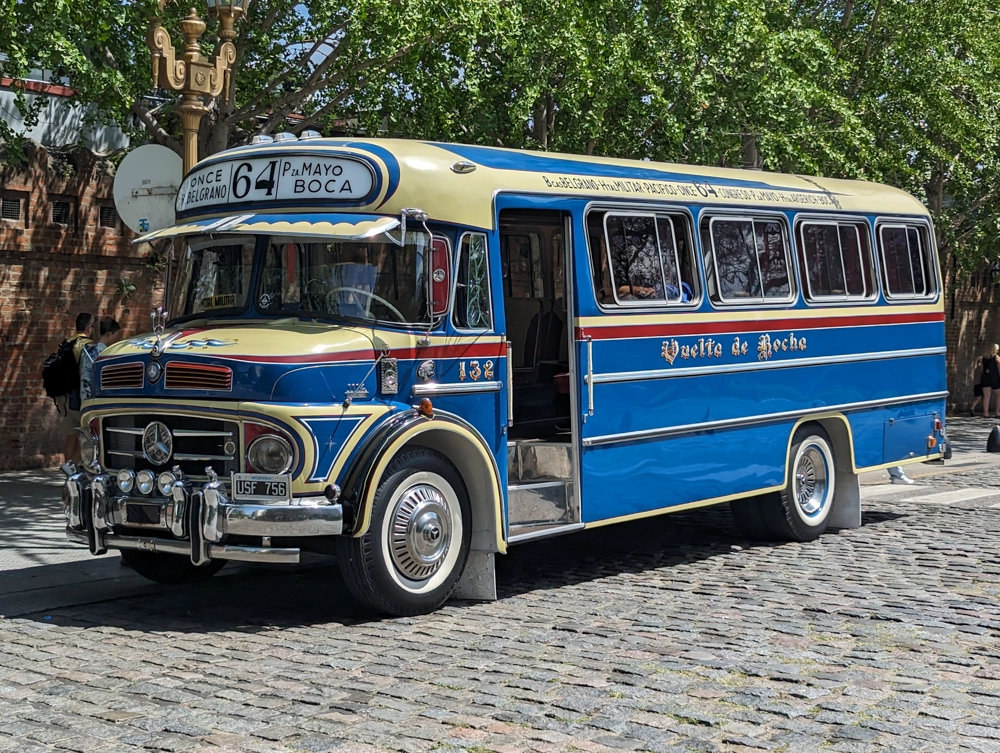
Uber in BA has several categories. Normal Uber usually gets you an ancient Fiat with 500,000 km on the clock. Uber Priority gets you the same Fiat but a tiny bit quicker. Uber Comfort gets you the same Fiat, but with the windows rolled up and the decrepit air-con blasting air like the breath of a hot dog. In all seriousness, Uber was a cheap and easy way to get about the town.
We also used a few taxis and found them comfortable and reliable if not always air-conditioned. We had no arguments with any of the drivers about turning on the meter.
We also found BA to be a very walkable city, it has been laid out on a logical block formation, so it is simple to navigate. The pavements are wide, and there are pelican crossings every few hundred yards so getting over the wide roads is easy. Often, we would travel to an area by car and spend the day exploring on foot before taking a car home again.
BA is the first city we have visited in South America where we would have felt comfortable driving and would certainly have hired a car had we planned to travel much out of the city. Unlike the big cities of Brazil, which have traffic like the chariot race in “Ben Hurr” the driving in BA seemed calm, logical and respectful. The roads are wide and there also be plenty of parking spaces. The city’s grid of roads is all one way, which can make things a bit tricky, but overall this calms the traffic. If you are not planning to leave the city, hiring a car is probably not worth the hassle, with Uber and taxis being so cheap.
Where to Stay In Buenos Aires With Kids?
There are is no shortage of places to stay in Buenos Aires, after all it is the largest city in Argentina and the second largest on the contient, but we have a favourite area – Palermo!
Palermo is a beautiful, tree-lined neighbourhood with a delightful blend of urban vibrancy and family-friendly charm. It’s leafy streets and parks provide a perfect backdrop for leisurely strolls and are a great place to unwind after a day exploring the city.
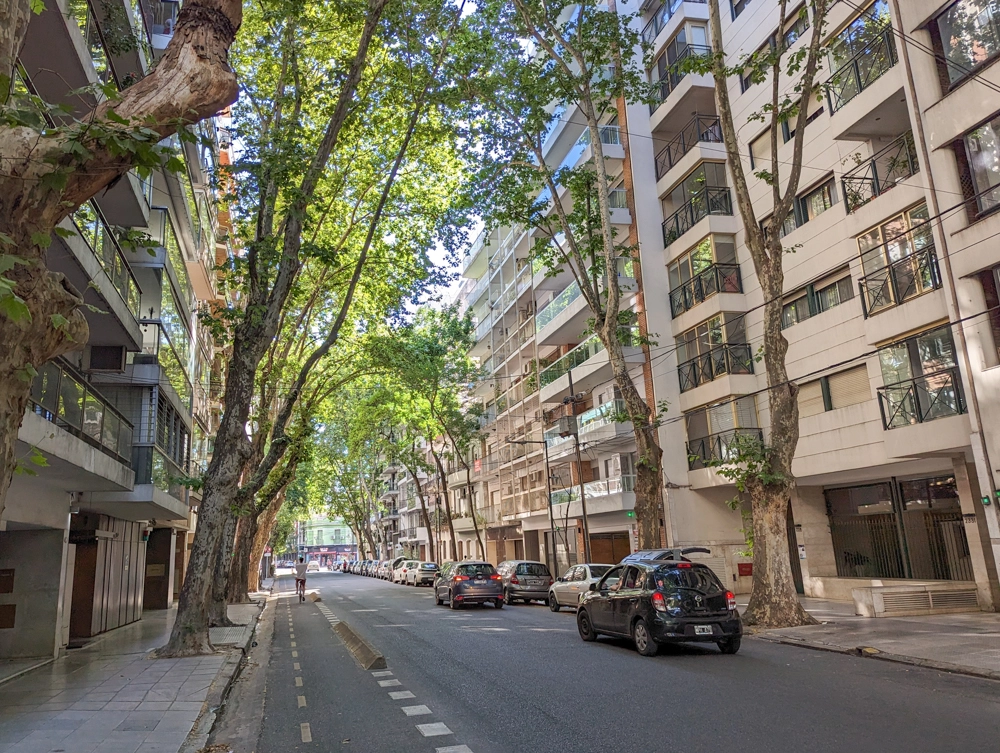
It has a huge range of hotels and apartments to hire depending on what you prefer, and you will find a great range of options on Airbnb and booking.com. We booked an apartment with a rooftop pool which the kids loved! It was ideal to dip into and cool off.
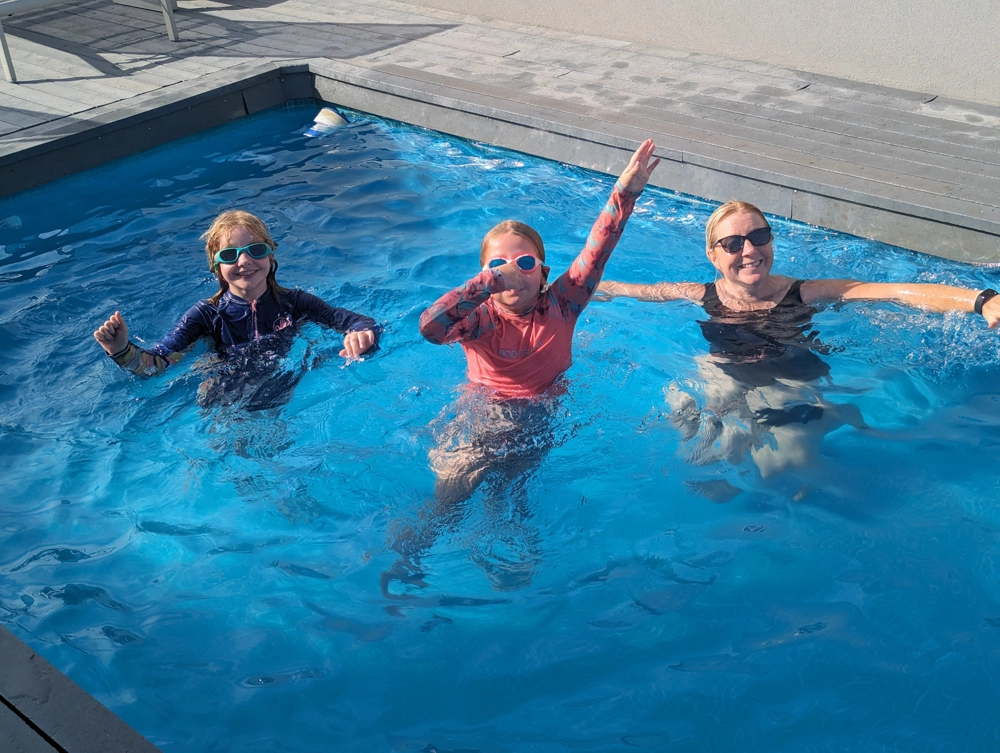
Palermo has a great array of restaurants, bakeries, coffee shops, greengrocers, and general stores. We stayed here for a week and very quickly found ourselves at home, in fact we even had the “we could move here forever” conversation! Coming from a family who love living in the countryside this is high praise indeed!
It is worth noting that “kids meals” are not really a thing in Argentina, and those places that do offer them charge the same price as adults. What we did with Georgia and Eva was order one main and ask them to split it into two plates. Everywhere we ate was happy to do this; the hard part was getting the girls to agree on what they wanted to eat!
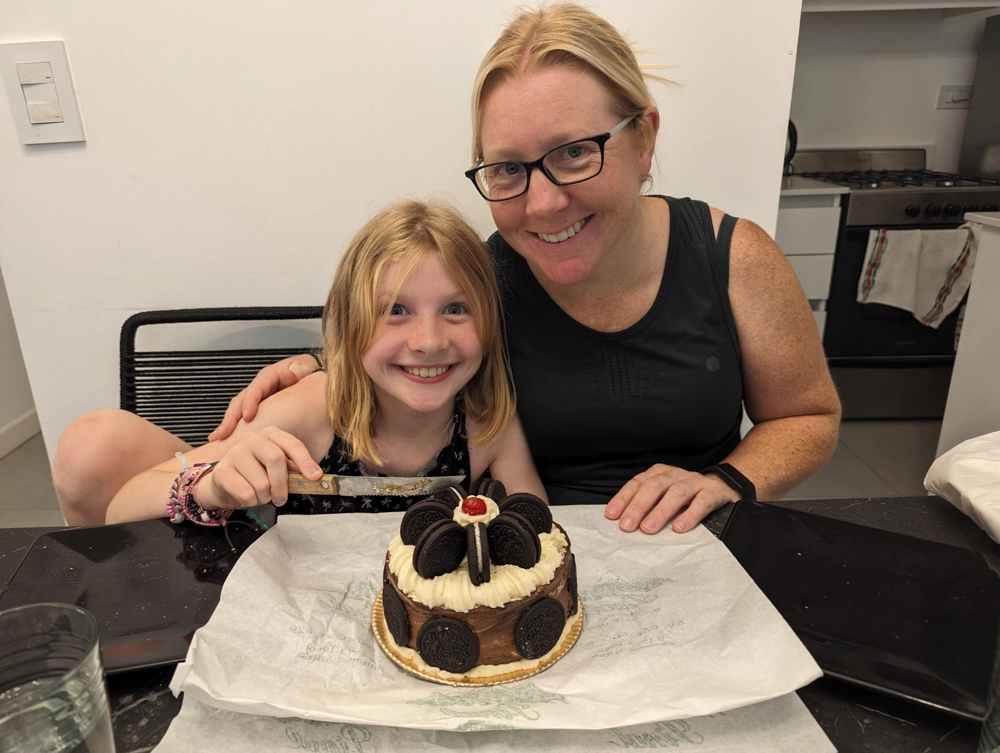
Our only complaint is that Palmero is a little far out from a lot of the main tourist attractions so we did find ourselves taking some quite long journeys to get about.
Spending Money In Buenos Aires
You might think this is a strange thing to add to a travel blog; after all, how hard can it be to spend money? In Buenos Aires, surprisingly hard at times!
In fact, in all our travels we have never been anywhere where parting with cash has proven such a challenge because so many shops, bars, restaurants and attractions will not accept certain means of payment.
For example, we have been to supermarkets that will only take cash (despite being a legal requirement for all shops to accept bank cards), we have been to supermarkets that will take bank cards only if you have a national tax ID card (which we don’t), we have visited tourist attractions that won’t accept any other payment apart from a Visa card, and we have booked bus tickets with agents who will only accept debit cards, not credit cards.
In short, if you are planning a day out in the city, you want to carry a Mastercard, a Visa and cash.
To make matters worse, the largest banknote available is the Arg$ 1000, worth about 90p/$1. If you want to pay for even a modest basket of shopping, you need to carry an absolute stack of notes. There is a rumour of an Arg$ 2000 note coming out soon, but with inflation running so high by the time it is in circulation, it will be just as worthless.
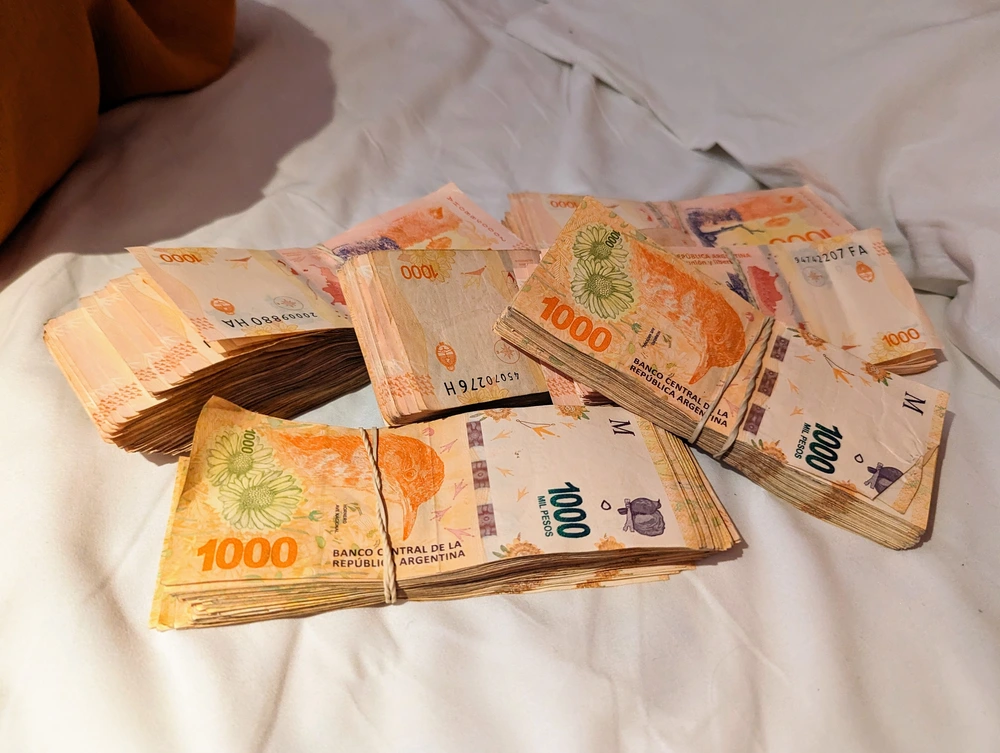
Getting hold of cash is also tricky. Due to the complicated nature of Argentine exchange rates (there are six at last count – Wander Argentina gives a great explanation), if you withdraw money at an ATM on a foreign bank card, you get a terrible exchange rate and are whacked with huge fees.
A much better alternative is to send yourself money via Western Union. To put some context on this, when we withdrew cash, we had a rate of Arg$ 350 to £1. If we got money via Western Union, it was Arg$1100 to £1, nearly 3 times as much.
Food and Clothes Shopping in Buenos Aires
The high streets of BA remind us of the UK back in the 1990’s. This was a simpler time before Amazon and the gigantic supermarket chains moved in and effectively killed the small trader. It is full of small independently run stores, some of which like book shops and travel agents, have long been extinct back home.
We stayed in an Airbnb for a week and took the opportunity to prepare some home-cooked meals in an attempt to slow our ever-expanding waistline from all the eating out! It was delightfully old-fashioned to visit a butcher, a greengrocer and then a general store when picking up what we needed. Supermarkets here also stock the excellent and very cheap Malbecs from Mendoza as well!
BA also has no shortage of clothes shops with the full range of designer brands you would find in any major city which were slightly cheaper than in the UK. We spoke to the staff of the Levi’s shop about how they were coping with the incredibly high inflation, and they answered that they were having to adjust prices on the clothes at least once a week to keep up!
Finally, if you are heading on to Patagonia from BA and want some cold-weather gear, there are plenty of great outdoor shops with everything you should need.
Things To Do In Buenos Aires With Kids
We stayed for a week and wish we had stayed longer! There is so much to experience in this great city from amusement parks to admiring the fantastic art of Latin America, so lets dive in!
Mercado San Telmo – San Telmo Market
Full disclosure: we came off a 10-hour night bus with the girls at 7 am on a Sunday morning before heading straight to this market, so our recollection might be a bit sleep-deprived!
Mercado San Telmo is a bustling market, bursting with colourful stalls and lively energy; it is a treasure trove of local flavours and artisanal crafts. Dare we say it, but it outshines even Mercado Municipal de São Paulo. Unlike Caminito in La Boca, it seems to have a lot of genuine artisans selling items they make themselves. Of course, there is still the usual array of tourist tat, but it does not dominate.
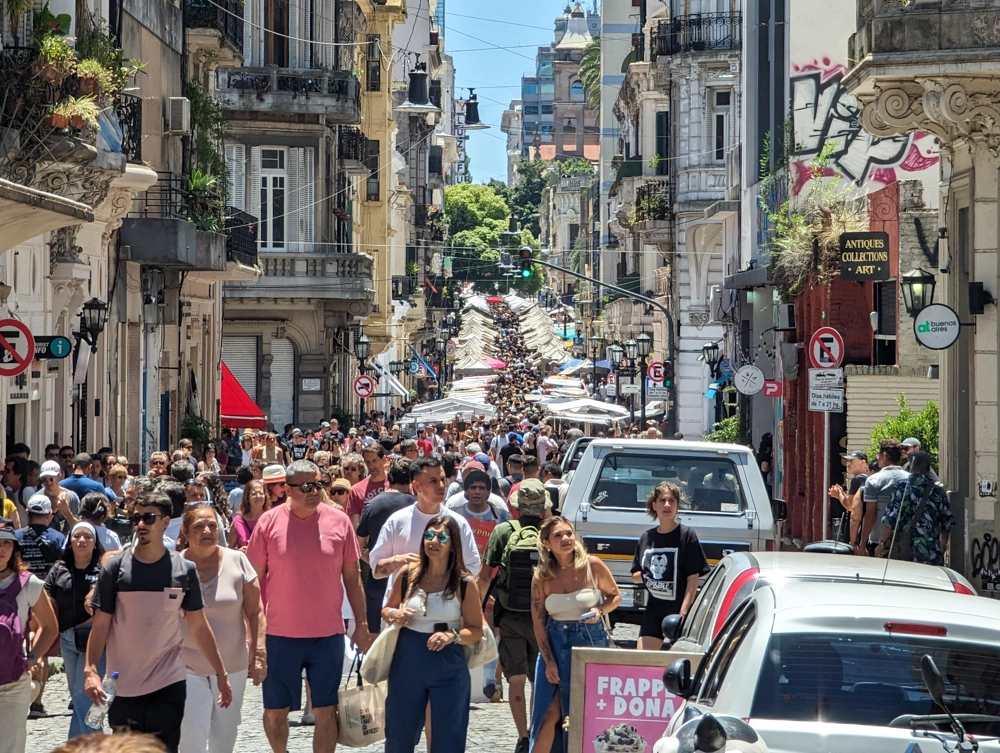
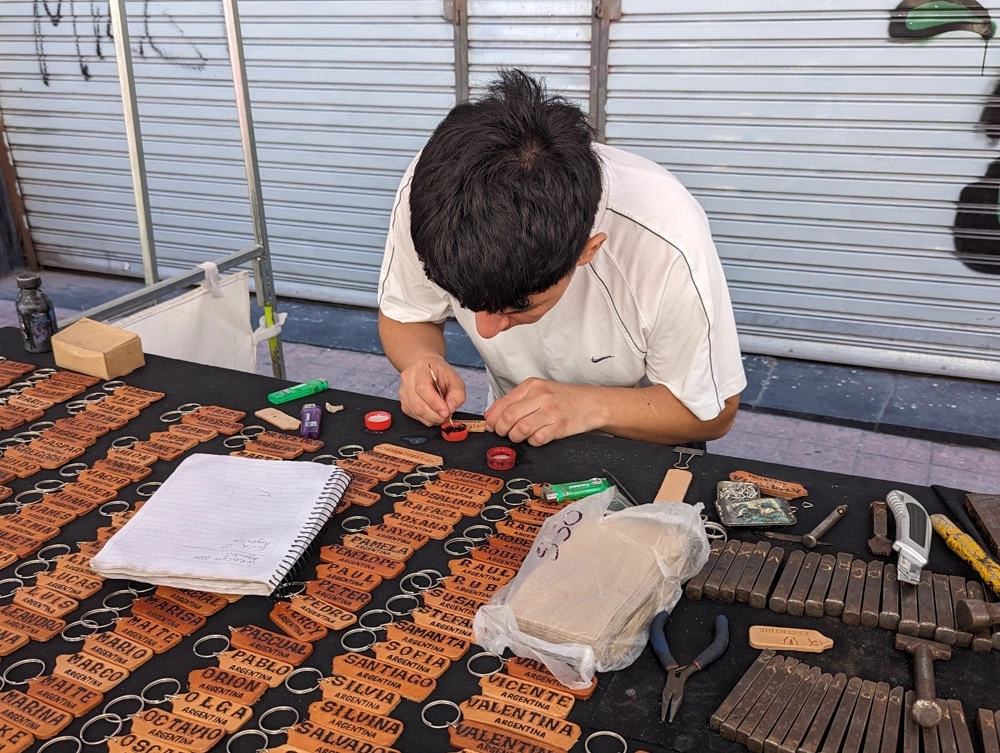
Tuesday to Saturday, the market is located in the gorgeous, wrought iron hall with a host of cafes, butchers, greengrocers, and antique stands which you can weave your way through.
The market comes to life on Sunday when it spills out to the streets and fills just about every inch of Defensa from Plaza Dorrego to Av Belgrano! Because of our early arrival into BA on the night bus, we arrived at the market just as it was opening and spent an hour exploring the stands before it got too hot or busy. By lunchtime, it was packed.
We actually visited the market twice. On our first visit on Sunday, we started at the Belgrano end of Defensa, and by the time we reached Mercado San Telmo at about 12.00, it was so busy we didn’t want to go in with Georgia and Eva. After our experiences at Christ The Redeemer, we know all they can see when somewhere is so packed is the bums and navels of other visitors. With hindsight, we should have started at Mercado San Telmo and then walked the other way down Defensa on the Sunday.
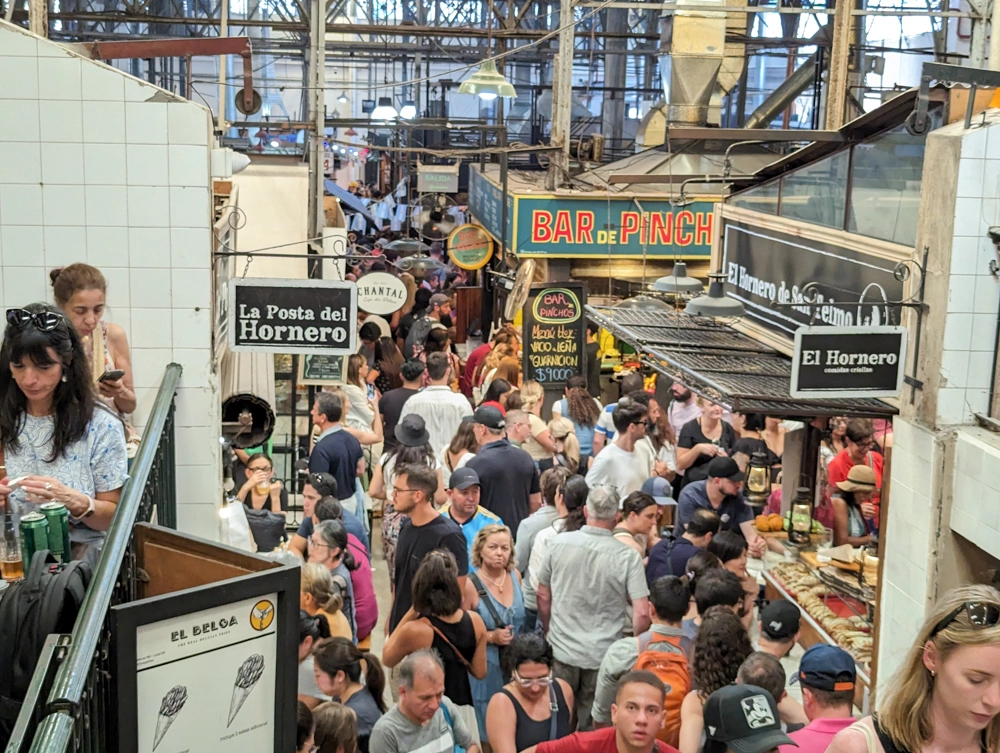
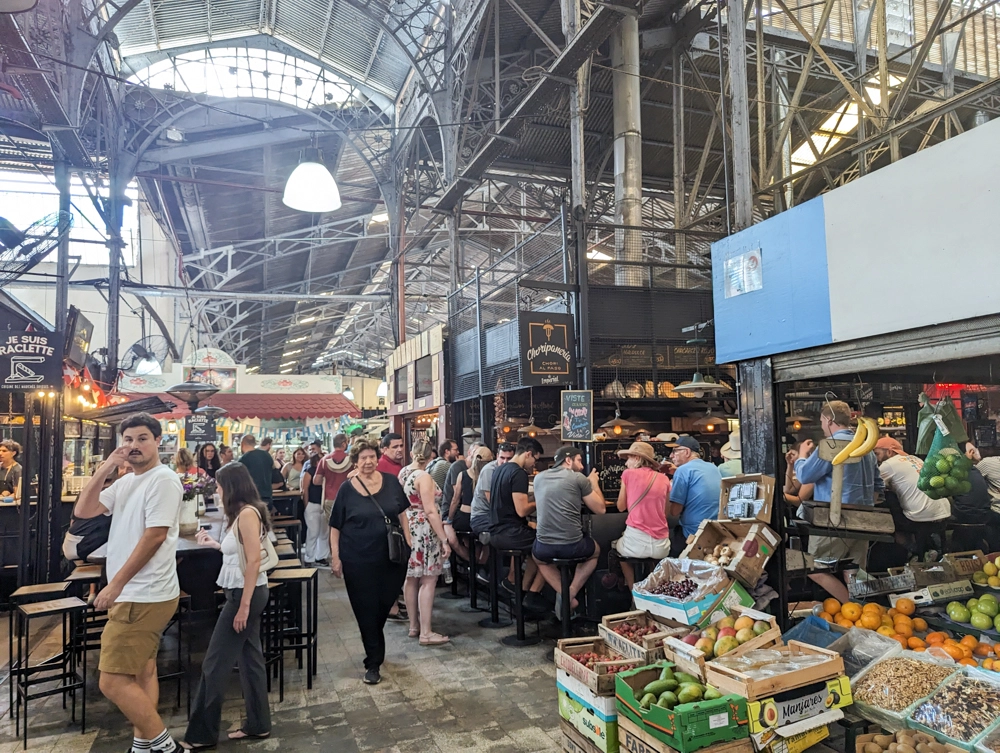
We really wanted to see the market hall, so we came back on a Wednesday and it was much quieter. We got to explore the stalls and enjoy an excellent lunch without being jostled.
One word of warning: if you do visit on a Sunday, be careful with your bags and valuables. The streets and market are so packed that it is easy for pickpockets to target you.
Museo de los Niños Abasto – Absto Kids Museum
Probably the kid’s favourite thing in Buenos Aires, except maybe the bakeries!
The Museo de los Niños is based on a brilliantly simple idea: unleash kids to explore and engage in activities typically off-limits.
It is the most interactive museum we have ever visited. Kids can zoom around a supermarket and fill a trolly with whatever they like, flip burgers at Mcdonald’s, open a bank safe and peek inside, step into the shoes of a racing driver in a real car, go down a toilet and see where a poo goes, and even try their hand running a TV studio.
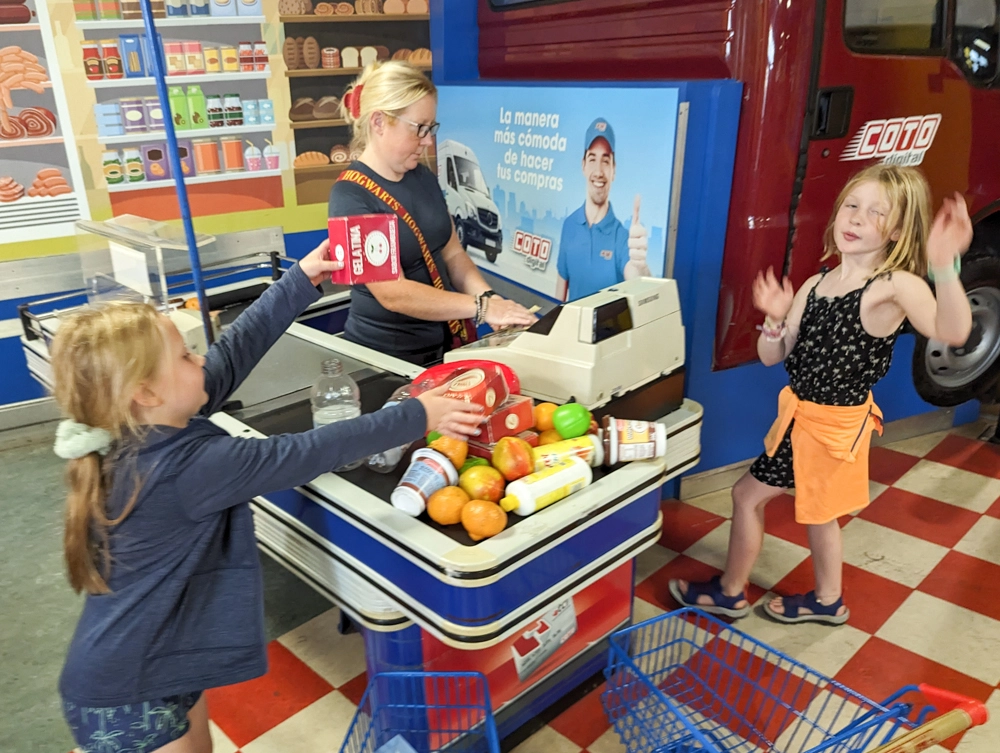
It is all presented in a highly interactive and captivating way that Georgia and Eva really connected with, and to be honest Kirsty and I did as well!
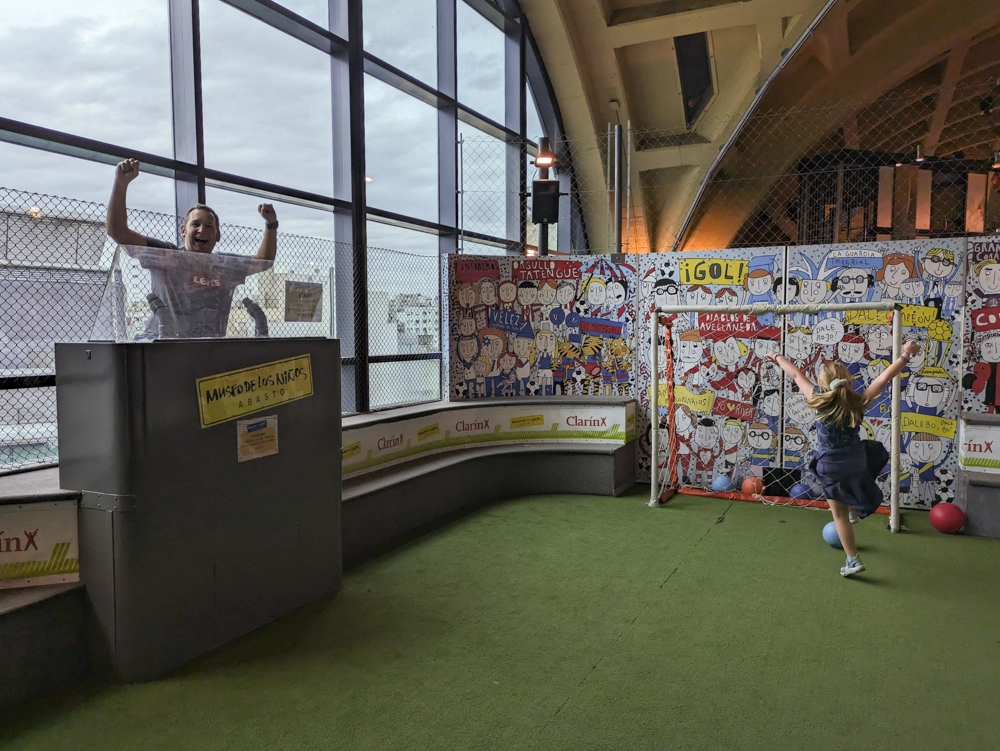
As an experience, it is probably best suited for children 5 – 7 years old, but the girls (8 & 9) still had a great time here. If we had a criticism, it would be that it did not feel especially Argentinian. It is a concept that could be done in just about any major city, now I think about it I wonder why it hasn’t.
If you want to visit, the museum runs three sessions daily, from 12.30 – 14.50, 15.00 – 17.20 and 17.40 – 20.00. At the end of each session, the staff asks everyone to leave the museum so it can be cleaned and reset for the next session so try an arrive as close as possible to the start time. We spent an hour and a half here before being asked to leave which was just enough, but we would have happily done more.
Entry is Arg$ 1,100 per adult and Arg$2,900 per child.
Cementerio de la Recoleta – Recoleta Cemetery
It may seem a strange thing to take children to a cemetery, but Cementerio de la Recoleta offers a glimpse of the rich history and architectural beauty that made Buenos Aires famous.
The final resting place of Eva Perón, the cemetery is renowned for its elaborate mausoleums, statues, and monuments and the incredible craftsmanship that has gone into the tombs.
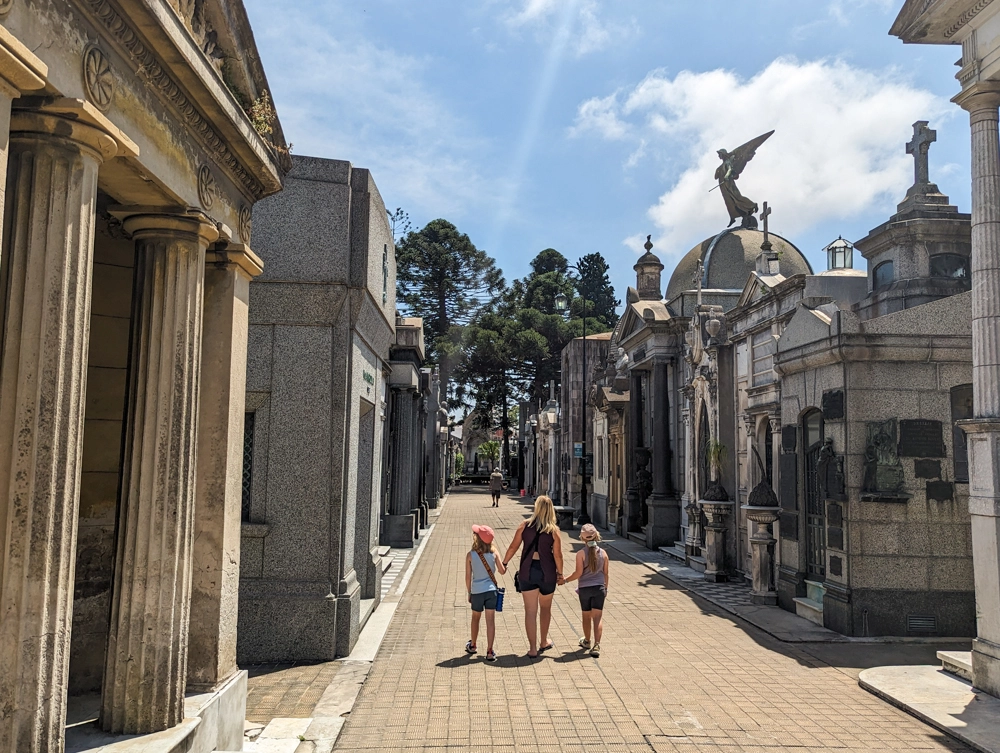
Another interesting aspect of the cemetery is the mausoleums that have fallen into disrepair. Once the final resting places of the rich and powerful, some are now neglected and abandoned. The silent decay raises questions about the fate of these families and adds a layer of mystery to the cemetery’s history.
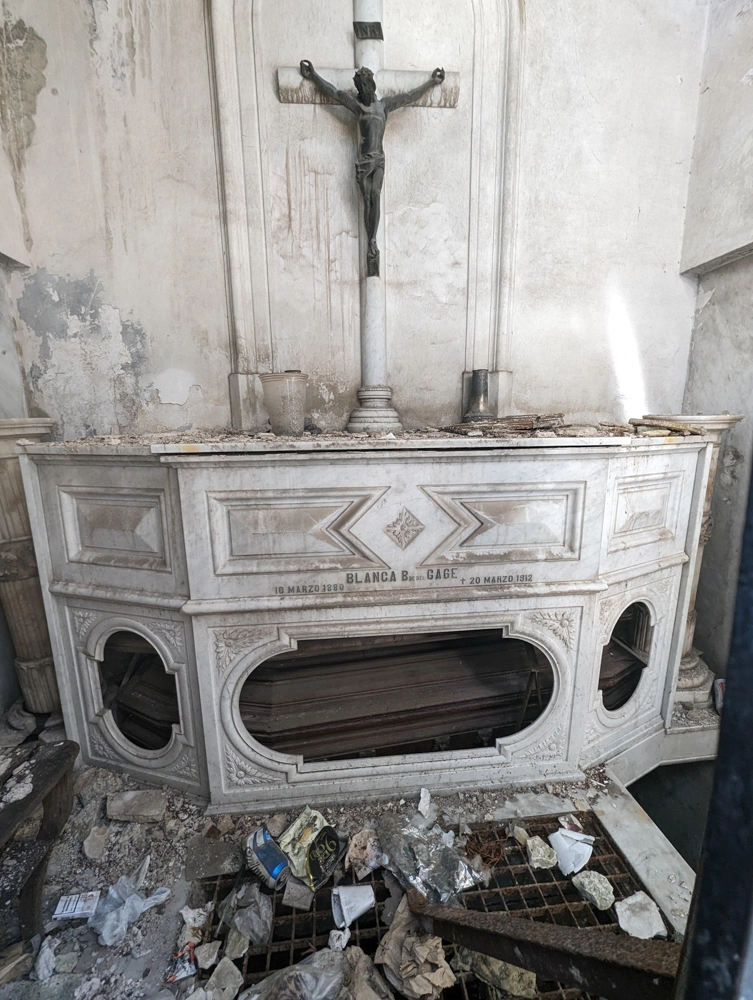
Exploring a cemetery can teach kids about the importance of respect, empathy, and honouring the memory of others. We took it as an opportunity to discuss the rituals and traditions associated with death and how different cultures approach mourning and remembrance.
Before we visited, we watched the Disney’s “Coco”. While its setting differs, the movie is a helpful primer on Latin American funeral traditions.
It is also worth remembering that Cementerio de la Recoleta is not merely a museum; it remains an active burial site. We encountered an ongoing funeral during our visit, underscoring the significance of respecting this solemn space. Be sure to explain this to your kids and set appropriate behaviour expectations.
Entry costs the strangely specific Arg$ 3768 each to enter; children 7 and under are free. Payment is only on a bank card, and when we went, only Visa was accepted. We ended up paying for a lovely Italian couple to get in, as they had only brought cash.
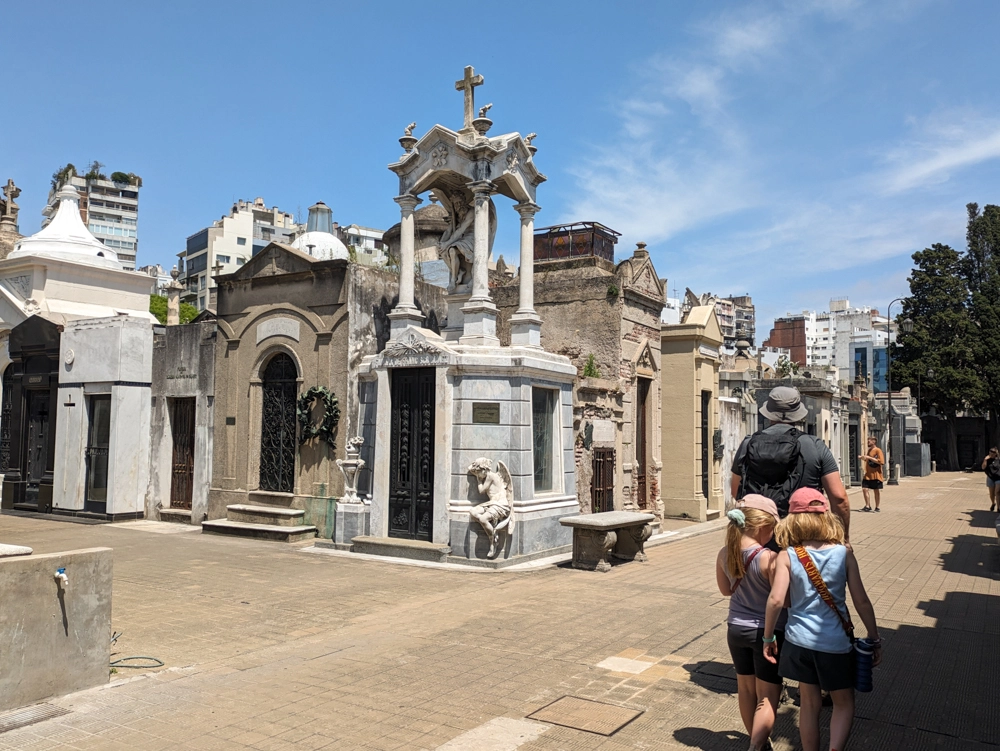
Try and visit early in the day and make sure you wear plenty of sunblock and drink plenty of water. There is little shade on the cemetery streets, and the white marble of the mausoleums reflects the heat onto you, turning the place into a suntrap.
If you do need to cool off after, the beautifully air-conditioned Recoleta Urban Mall is just around the corner from the main gates and we took our sweet time walking through it! We also went to The Food Truck Store for lunch and had one of the best burgers of our time in BA.
Take a Cookery Class
“To know a people, you must know their food”
As we travel, we try to take at least one cooking class in every country we visit as we have found it a guaranteed way to connect with the local people and culture. There is something about the communal nature of cooking that encourages openness and helps foster a connection, and this proved to be true on our visit to Buenos Aires.
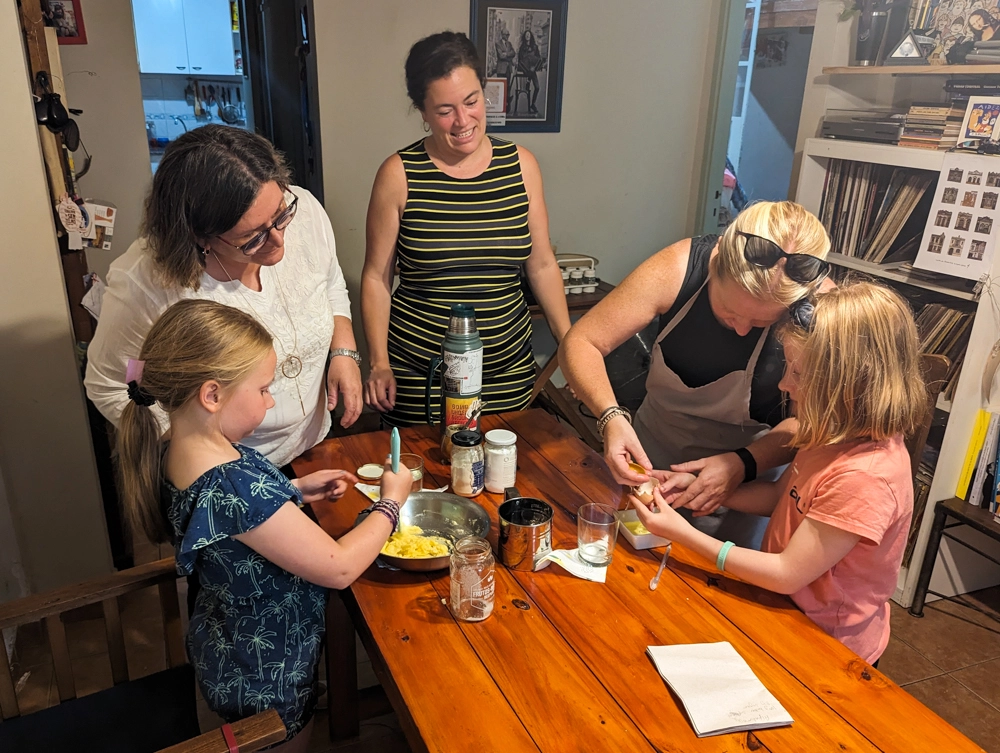
We took a cooking course with wonderful Laly from Buenos Aires Mío and spent a happy few hours with her lovely family in her kitchen in San Telmo. We were taught how to make empanadas and delicious alfajores biscuits, and we even got to try mate for the first time as well!
Empanadas are a national staple in Argentina, and every region, indeed every family, makes them slightly differently. Their simplicity is key to their versatility and we have had them with all sorts of fillings but minced beef is the most common. Laly talked us through how to make them from scracth, including how to get the pastry just right and how to mix the filling. We then got to enjoy the fruits of our labour with an excellent glass of red wine!
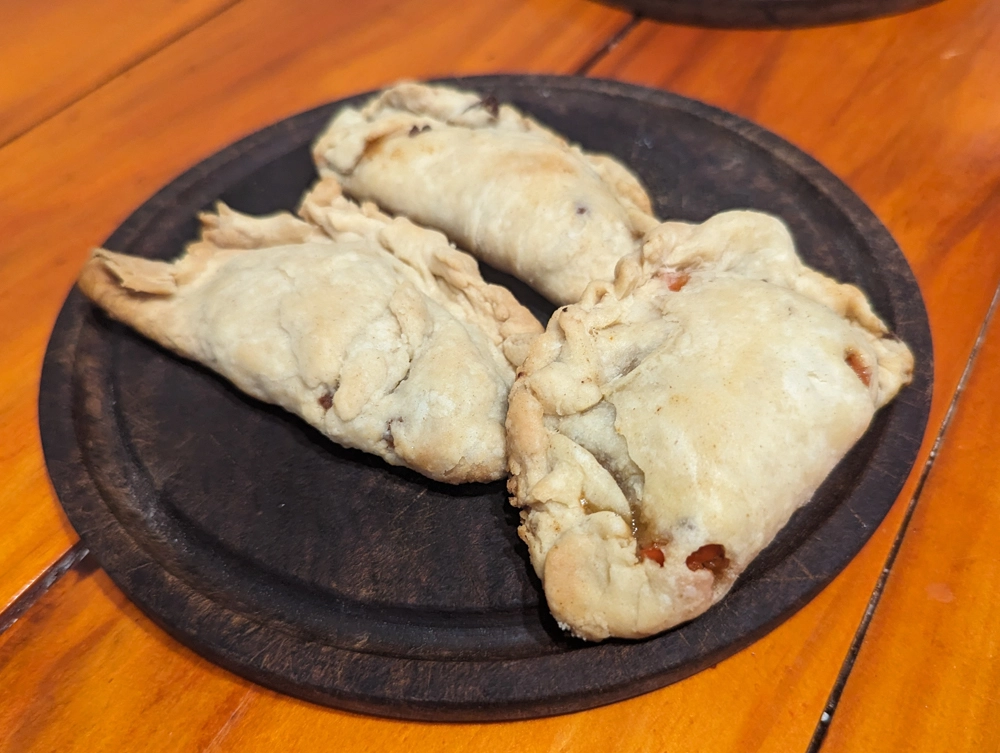
The alfajores were a real treat, especially when served with a big dollop of Dulce de Leche!
We did make a mistake booking Laly through a 3rd party website rather than going direct to her – we ended up paying well over the odds for the class so if you can, book direct through her Instagram.
We are so pleased we took the cookery class with Laly, a highlight of our visit.
Museo de Arte Latinoamericano de Buenos Aires – Museum of Latin American Art of Buenos Aires
We know that taking kids to an art gallery can be a gamble – it can be either an enriching experience or an absolute chore depending on what mood they are in. In fairness, galleries aren’t inherently child-friendly, and each child’s level of engagement varies so you have to set realistic expectations.
We are happy to report that the gamble paid off on our trip to the Museum of Latin American Art! It was a wonderful experience and we would heartily recommend it; we spent just under an hour there taking in the magnificent works. Certainly, if we were visiting without the girls, we would have spent longer, but we know not to push our luck!
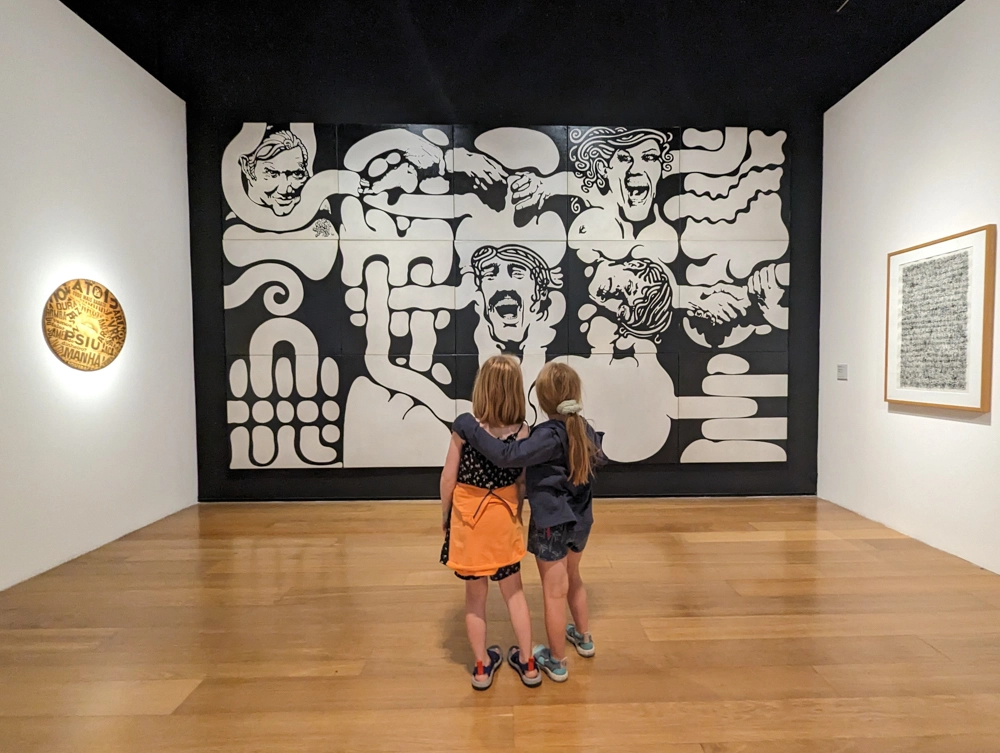
At the moment, the top floor is closed, but the first floor has several beautiful collections of works of art that are engaging and thought-provoking that Georgia, our family artist, took a lot from. The information on each collection is provided in Spanish and English which makes it accessable.
If you do go, here’s one word of warning: the museum covers some adult themes in places. I found myself explaining to Georgia and Eva why the nice lady in the picture was naked, what it means to be “hung, drawn and quartered”, and the death of Che Guevara. It was nothing if not educational!
The museum costs Arg$ 3,000 per adult and Arg$ 1,500 for the girls and Wednesdays are half price.
Jardín Japonés – Japanese Garden
Just west of the Museum of Latin American Art, the Japanese Garden is a peaceful escape in the middle of this bustling city. It was built in 1967 in sharp contrast to the towering buildings nearby to welcome Crown Prince Akihito of Japan. It was then donated to the people of Buenos Aires, in gratitude to Argentina for opening its doors to the Japanese people. It is probably the most photogenic place in the city!
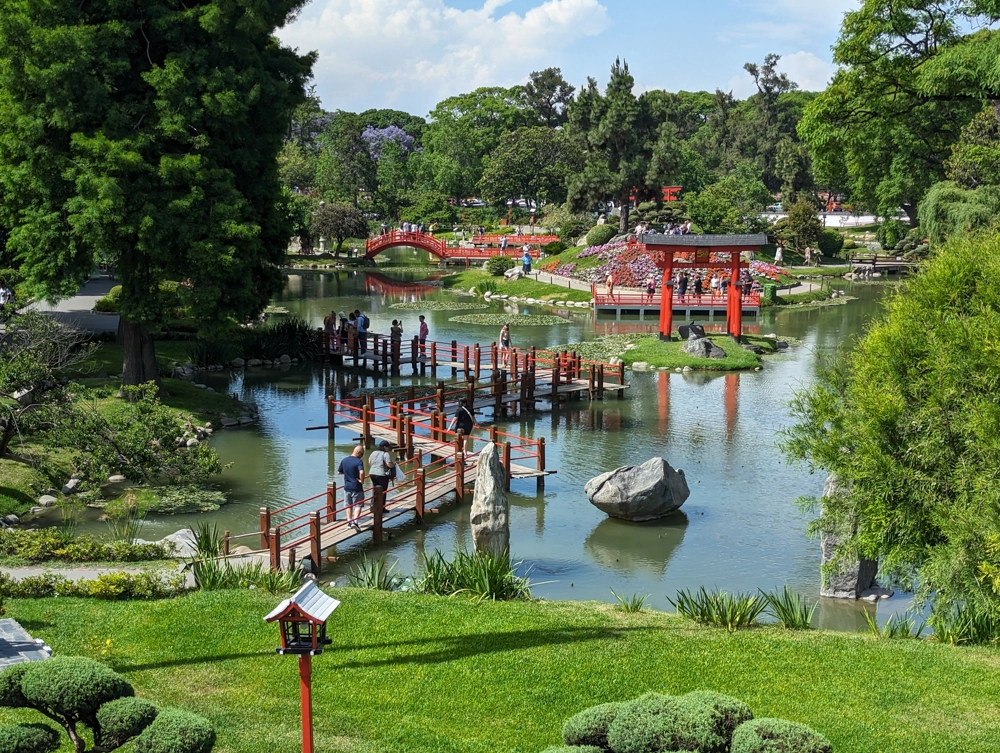
The gardens do a wonderful job showcasing the beauty of Japanese artistry and nature’s wonders. We spent a happy hour wandering around the winding paths and over the charming bridges admiring the bonsai trees, koi fish and traditional decorations.
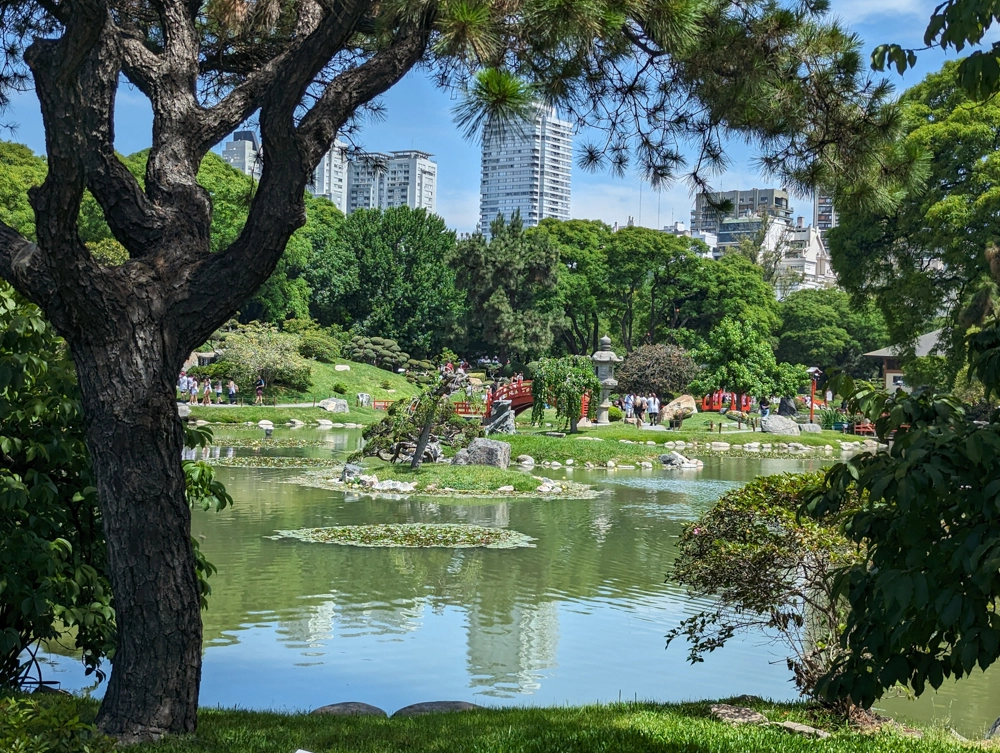
There is also a cultural centre on site where we got to admire some incredibly intricate origami and even have a try at our own!
The park costs Arg$ 690 for adults and children are free to enter and is perfectly accessible with a pram.
Explore Plaza de Mayo and Casa Rosada
Much more than just the city centre, Plaza de Mayo is the historic heart of Buenos Aires. It is a welcome space for families to explore the great cultural and historical legacy of Argentina.
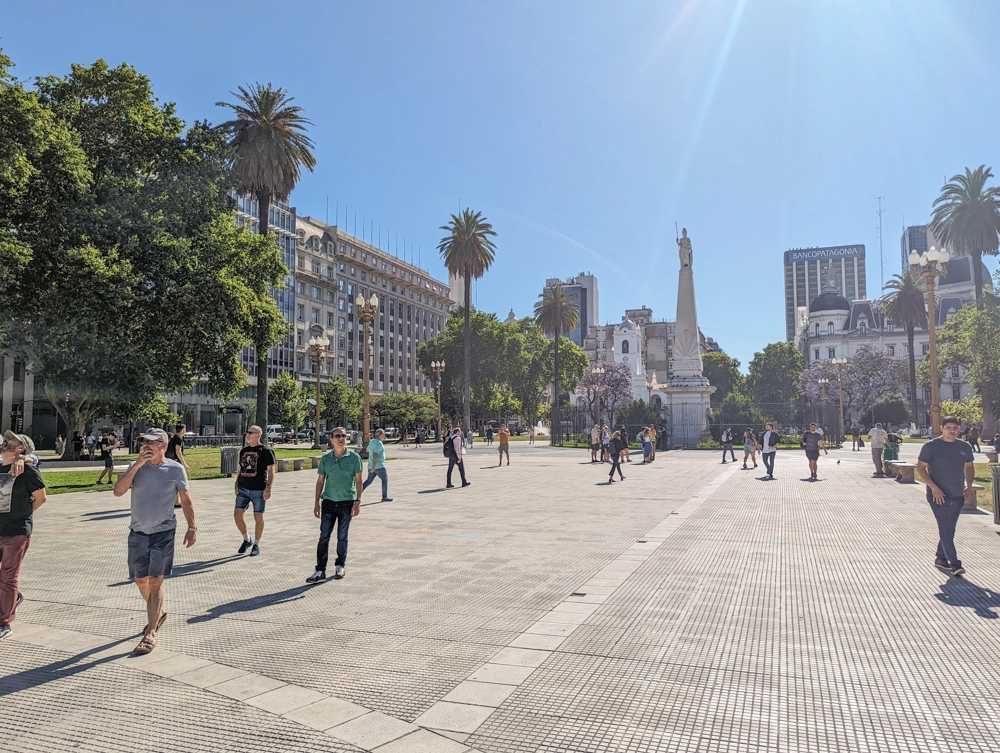
Plaza de Mayo serves as a central hub for cultural activities and political expressions in Argentina and provides an educational yet captivating experience for families.
It is worth taking a look at this emblematic square but once you have admired Casa Rosa and the other grand buildings there is not much to do. It is best visited on the way to or from somewhere else.
El Ateneo Grand Splendid
You just know that anything that has the words “grand” and “splendid” in its name has to be good!
According to National Geographic, El Ateneo Grand Splendid is “the world’s most beautiful bookstore”, and it lives up to the hype. Set in a wonderfully preserved theatre, it feels like a temple to the written word. The book shop is a short walk from Recoleta Cemetery and well worth the diversion.

There is a huge children’s section downstairs, and when we visited there was a large “Harry Potter” display, the girls were delighted!
We enjoyed about half an hour here exploring the shelves together. It is free to enter and has bathrooms available. As you would expect, the majority of the books available are in Spanish but there are some English titles available as well.
Take a Tango Lesson
Put on your dancing shoes for a little Latin passion. BA is the birthplace of the tango, and we could not leave without learning the basics. Georgia and Eva both do modern dance and gymnastics back home in the UK and took to it wonderfully, Kirsty and I not so much!
We returned to Laly at Buenos Aires Mío at her home in San Telmo and had a great time. She explained the history of the tango and what it means to the city then took us through some simple steps and routines.
The lesson cost Arg$ 15,000 for all four of us for an hour and if we were staying longer in the city we certainly would have returned for a second lesson!
Caminito in La Boca
Our one disappointment of the trip.
La Boca falls into the same unfortunate category as Khao Phing Kan (aka James Bond Island) or Nessebar in Bulgaria. It was once a genuinely beautiful place to visit but now has been totally overtaken by tourist tat and pushy sellers. Sadly, any charm that the cobblestone streets of Caminito may have had has been drowned under 1000 crappy Maradona t-shirts.
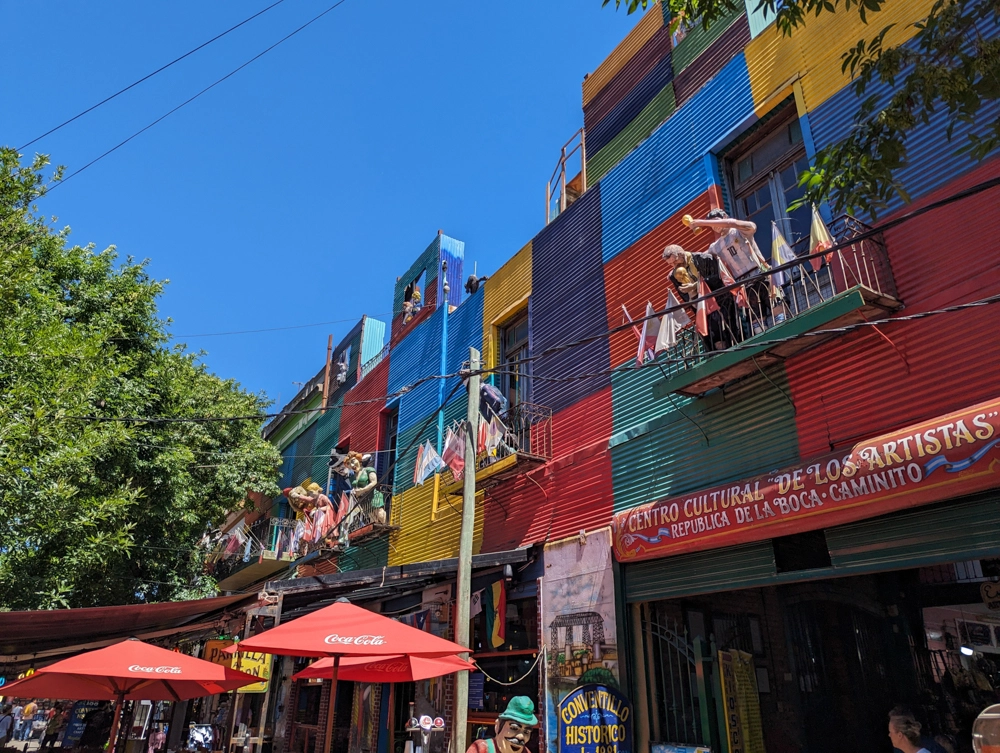
Originally, La Boca was a cultural phenomenon. Known as the birthplace of tango it was a bohemian neighbourhood brimming with the artistic culture of the immigrants. The houses they lived in were painted bright colours making La Boca one of the most unique and attractive places to live in the city.
Now, it is a sprawling mess of market stands all selling exactly the same tat. You will have deja vu as you walk from stall to stall and see the same things over and over again. If you look hard enough you can still find an artist or two working down the end of some of the side streets but even they only produce art for tourists to buy.
We arrived at 10.30 and it was getting busy. Laly, our tango and cookery teacher who knows the area well, says by 12.00 it is so busy with coachloads of people that you can hardly move. Sounds like hell.
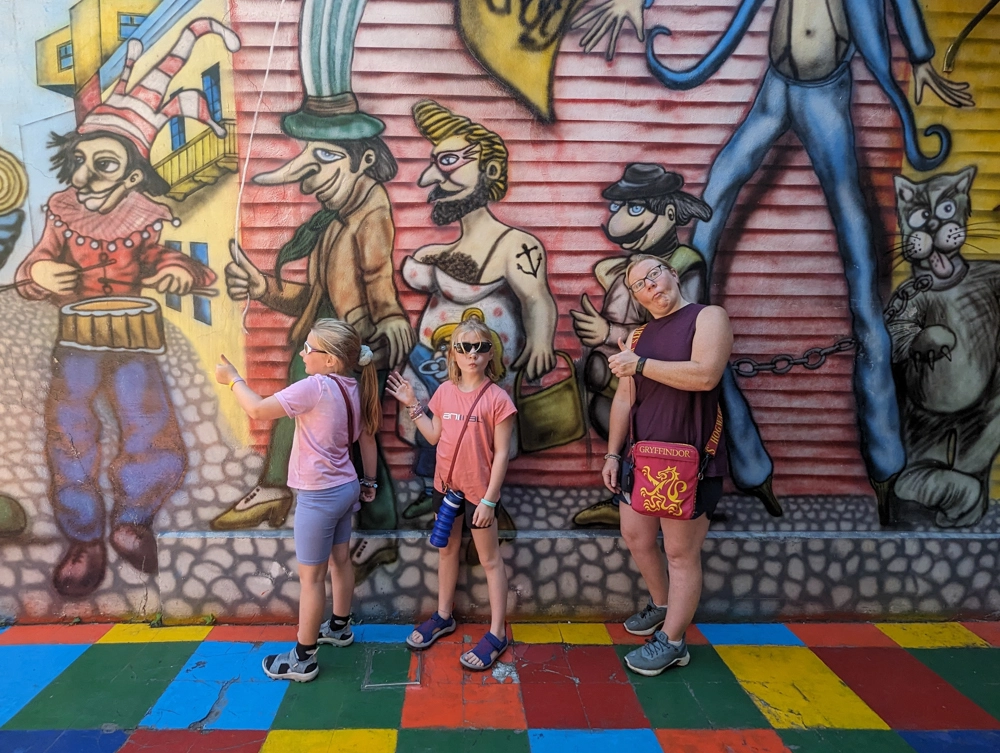
If you are close take a look, but it is not worth its own trip. If you want to see more of the neighbourhood this walking tour was recommended. Be warned however, La Boca does have a reputation for being rough.
Parque Tres de Febrero – Tres de Febrero Park
Tres de Febrero Park is an oasis in the heart of Buenos Aires. We enjoyed several happy walks here, escaping the worst of the afternoon heat on the tree-lined paths.
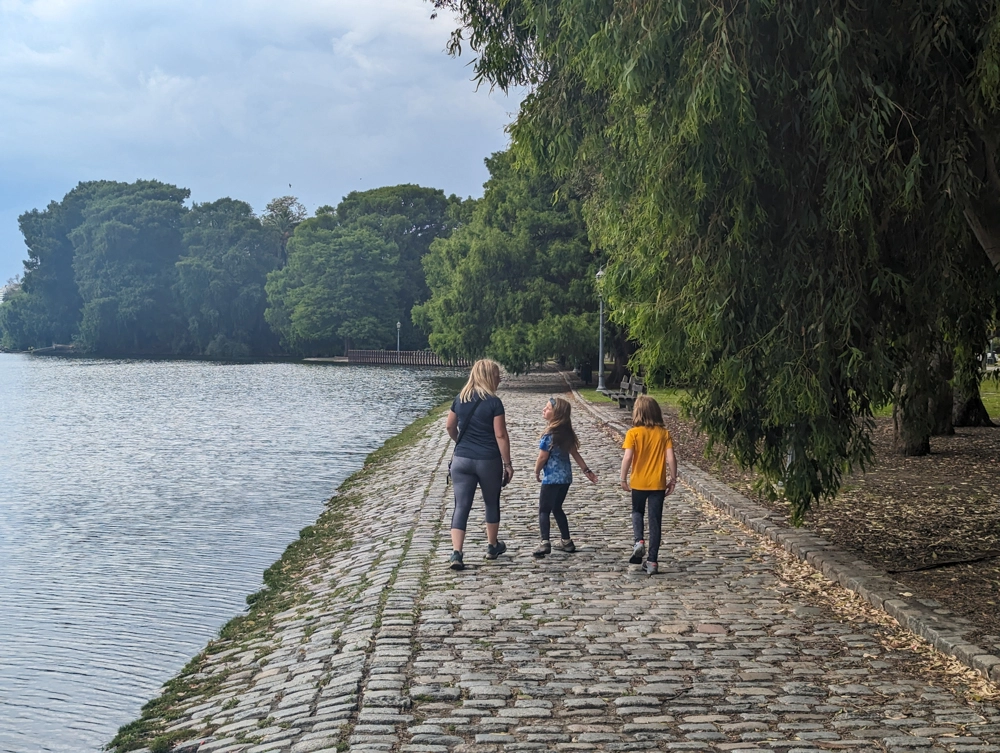
There are several playgrounds equipped with swings and slides, although annoyingly, they mostly had no shade!
There is also a lot of wildlife in the park, we saw an incredible skewer of egrets making their home on one of the islands.
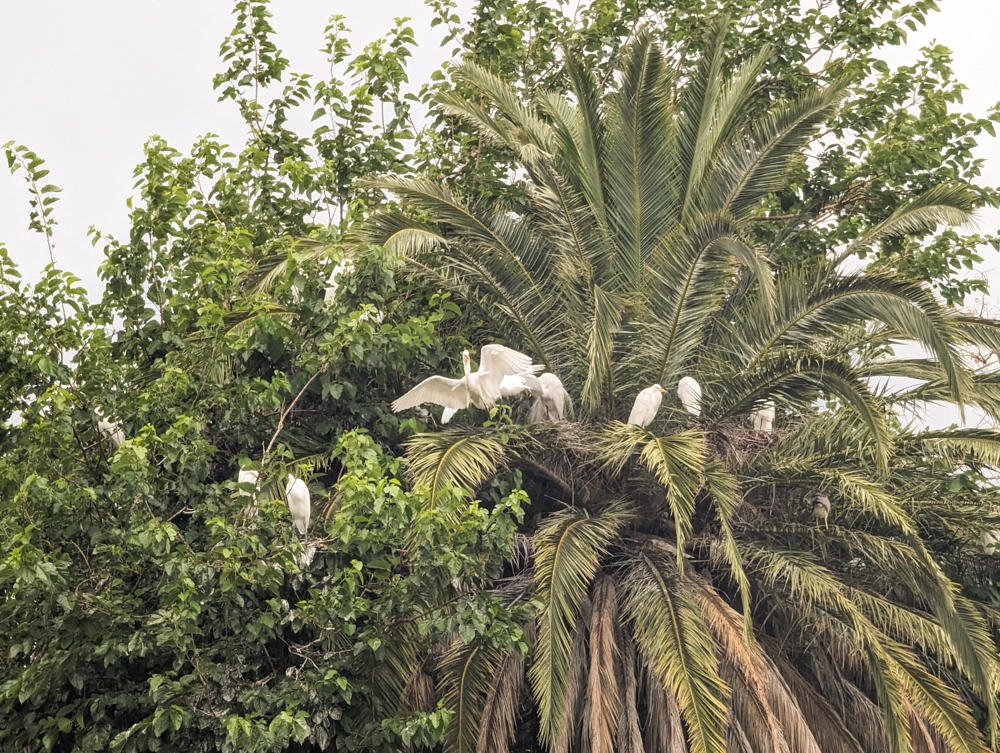
The park is a haven for family fun in Buenos Aires.
Have We Missed Anything To Do In Buenos Aires With Kids?
We had a great time In Buenos Aires with our kids and we were sorry to leave. It is rare to feel so at home somewhere so quickly.
We genuinely hope you have found our guide useful; if you think we have missed anything to do in Buenos Aires with kids or any of the information is out of date please let us know in the comments below!
If your next stop after BA is Iguazu check out our guides to the Argentine and Brazilian sides.
Thanks for stopping by!
